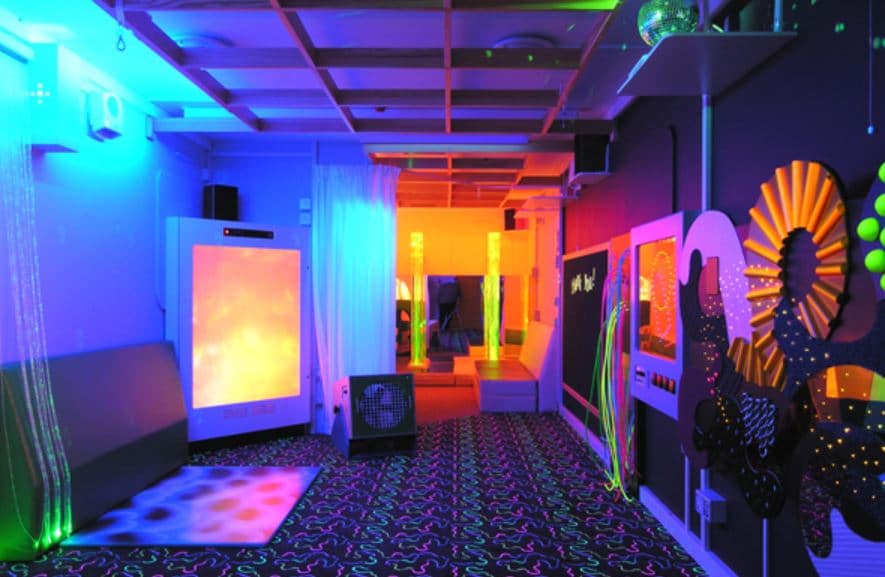
For many people, going to the hospital can be a stressful and anxiety inducing experience. For children who already struggle with these issues, a hospital visit can actually be quite traumatizing. One way to help reduce the stressors of a hospital stay and help children cope with the experience is to have a sensory room on site. The ability to step into a room that is designed to be soothing and calming can help children process their emotions and be better able to handle the visit.
At SensoryOne, we work with hospital design teams and staff to create sensory spaces suited to client facilities and patient needs. Whether in a hallway, corner, waiting area or full out sensory room environment we work with you to perfect implementation.
Benefits to a sensory room in a hospital
A sensory room is designed to be a calming and relaxing space where visitors can take a break from the over stimulation from the world around them. Inside of a hospital, a sensory room will have much the same purpose, however the benefits will vary a bit from using one in a school or home setting.
Help kids develop coping mechanisms – When kids, especially those with sensory processing disorders, are faced with an environment that they find stressful and triggering, the natural response is often to become agitated and act out. A sensory room can offer a space for them to learn how to work through their feelings and develop some better coping mechanisms.
Improves communication – Especially for kids who don’t have great verbal communication, a sensory room can help them to interact with their caregiver, parent or medical team.
They provide fun – In a highly stimulating and stressful environment like a hospital, a sensory room can provide kids with a necessary fun break.
Helps to pass time – Hospital visits will often drag out and take quite a long time so a sensory room is a great way for kids to pass time, without having to be surrounded by medical situations and equipment the whole time.
Help to reduce anxiety and encourage calmness – With several features that are designed to create a calm atmosphere and shut out the hustle and bustle of the hospital, a sensory space can help children to remain calm despite what they’re going through. Hospitals are adopting sensory rooms as must-have facilities.
Give parents a space to decompress – Although sensory rooms are primarily thought of as beneficial for children parents may find themselves appreciating its presence as well. A hospital visit is sure to be stressful for parents too, so having a quiet space to take a time out can help them better cope with the situation.
Can lead to better recovery after surgery or procedure – Children who are calm going into surgery tend to wake up afterwards in a similar way, so creating a space that can help calm and sooth in the time leading up to the procedure will have lasting benefits.
Features to include in a hospital sensory room
A hospital sensory room isn’t going to be much different than one you’d find in a school or therapy center. The ultimate goal is to allow children to be surrounded by an environment that will help them remain calm, entertained and happy.
Some top features to include in a hospital sensory room might be:
Dimmable lighting
Fiber optic lighting introduces infinite possibilities. Allowing the child to control the brightness or the lighting in the room can help them feel empowered and in control of the situation, especially when they are not able to be in control of things outside of the room. Additionally, dimmer lights are much more calming and relaxing than the harsh white lights typically found in hospitals.
Gentle music
The sounds of a hospital can be quite overwhelming and jarring. Playing calm music and sounds like a running river or waterfall can help drown out the sounds of a hospital and calm the children in the space.
Immersive technological equipment
An interactive projector or virtual reality system can help kids escape from the moments that are causing them stress and anxiety in a fun and engaging way.
Sensory walls, lamps or bubble walls
Visual and tactile experiences can be calming for sensory room visitors. A tool that encourages users to detach and focus on what they are looking at or feeling in their hands can help distract them from the events outside of the space.
Fidget toys
Small toys that kids can hold in their hands and fidget with are a great distraction tool, especially if you’re looking for something you can allow kids to take out of the sensory room when they have to leave. Items like silly putty, stress balls, fidget spinners and tangle toys are all inexpensive and effective options.
Relaxing furniture
Bean bag chairs, floor pillows, soft carpets and hammocks are all great choices for a calming sensory room.
A hospital sensory room is great for kids
In a setting that can cause quite a bit of anxiety and stress for the average person, a child is likely to be particularly affected. Creating a sensory room that can offer them a space in which to escape the chaos and over stimulation can lead to less agitation and anxiety, allowing for a better experience for everyone involved.



